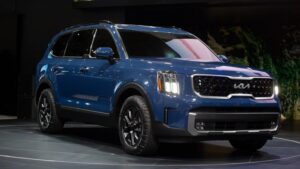With the longevity of gas engines, it is widely known that towing and carrying heavy loads have an adverse effect on fuel efficiency. However, electric vehicles, including electric pickup trucks, do not have the same extensive knowledge due to their relatively recent rise in popularity and sales. Nonetheless, as new EV models emerge, we are rapidly gaining insights. AAA’s recent study on the impact of payload on electric vehicle range contributes to unraveling some of the uncertainties surrounding this matter.
AAA obtained a 2022 Ford F-150 Lightning for testing purposes with the objective of addressing two key inquiries. Firstly, they sought to compare the road load force between the loaded and unloaded test conditions. Secondly, they aimed to evaluate the impact of the additional payload on driving range and efficiency.
According to AAA, road load force refers to the opposing force exerted on a vehicle as it moves on a road surface, causing a decelerating effect. This force can be attributed to factors such as aerodynamic drag, road surface friction, and mechanical friction. AAA also utilizes the term “road load curve” to describe the relationship between road load force and the vehicle’s speed.
The study revealed noteworthy findings regarding the impact of payload on the Ford F-150 Lightning. When a 1,400-pound load was added, the truck experienced 33.1 percent more force compared to the road load curve used by the EPA for electric vehicle certification. Surprisingly, even without any payload, the unloaded truck faced 5.6 percent more force. Additionally, AAA discovered that the unloaded F-150 Lightning exhibited 6.1 percent lower efficiency than the EPA’s estimated values, achieving 62 MPGe instead of the expected 66 MPGe. When loaded, the pickup’s efficiency further declined to 47 MPGe, representing a significant 24.2 percent drop.
There was also a noticeable reduction in driving range. While the EPA estimated a 300-mile of electric Vehicle range for the tested Lightning model, AAA’s findings indicated a range of only 278 miles when the truck was unloaded and 210 miles when carrying a 1,400-pound load. These loaded range results represented a decrease of 24.5 percent compared to the unloaded pickup and a substantial 30 percent deviation from the EPA’s estimated range.
In both gas-powered and electric vehicles, the impact of heavy payloads on fuel economy and range is evident. While gas vehicles may require hypermiling techniques to meet EPA estimates, the addition of 100 pounds to a vehicle typically reduces fuel economy by about 1 percent. However, the decrease in electric trucks’ efficiency surpasses this, with a substantial 24.2 percent dip observed when hauling a 1,400-pound load. This study highlights the importance of understanding the variance between EPA estimates and real-world performance, not only in terms of range but also fuel economy. It serves as a reminder that actual results may differ from official estimates provided by regulatory agencies.





